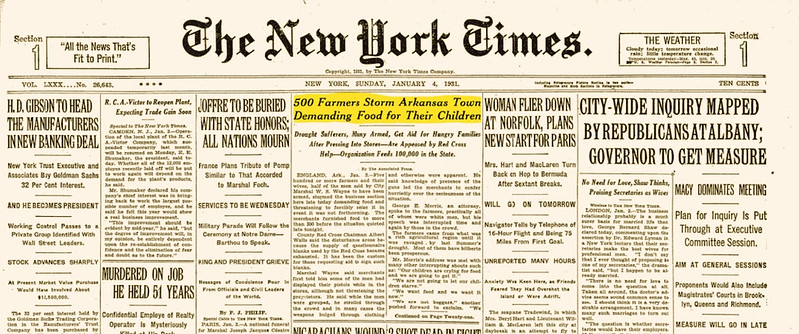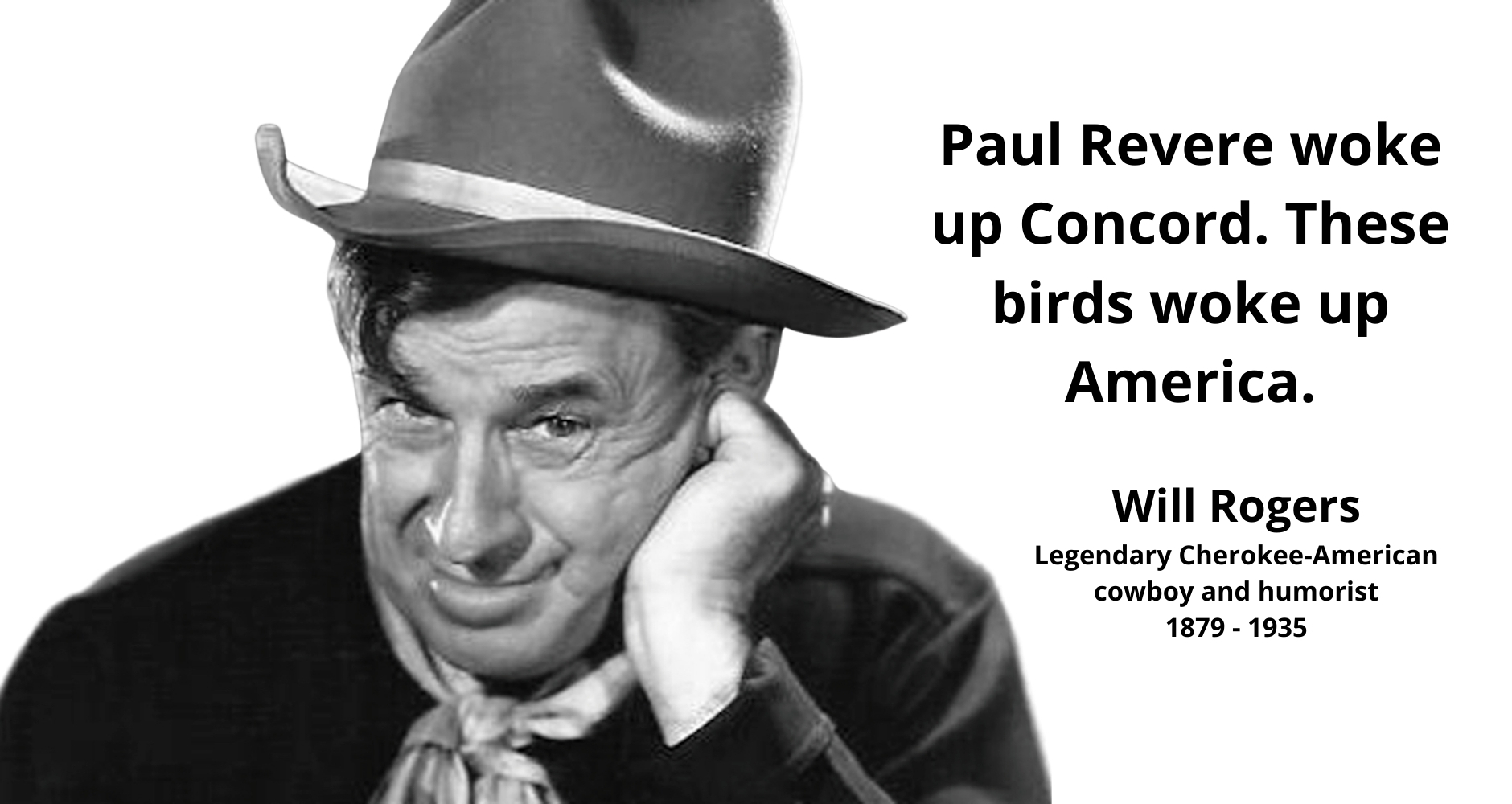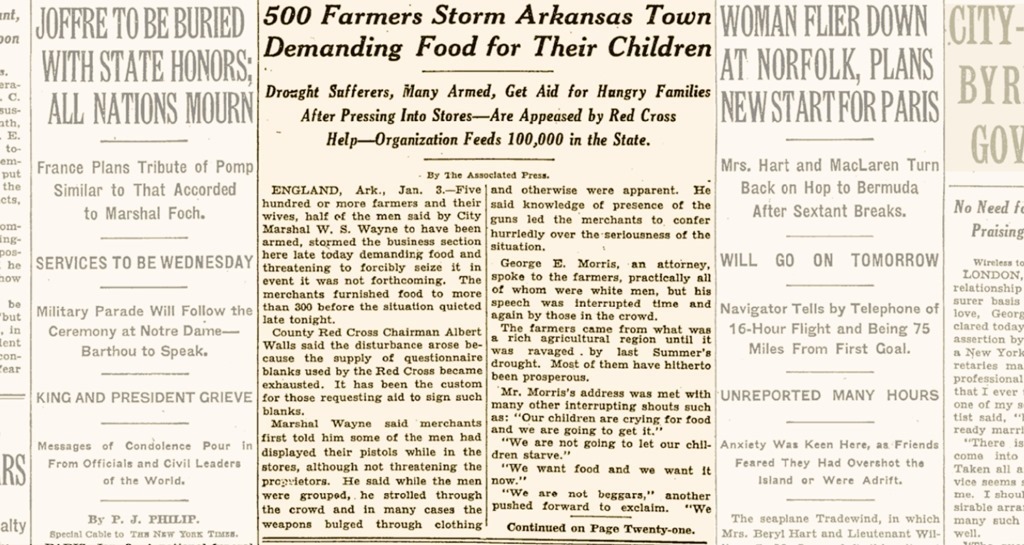 It was early in the Great Depression, just 14 months after the stock market crashed. In one of the richest agricultural regions of the world, farmers were suffering, especially those who eked out a living on the margins. Tenant farmers around England, Arkansas were out of options. During one forty-three-day stretch, the daily high was 100° or more on all but 1 day.1 Livestock was frail, the land was parched, the local bank had failed and the food bins were empty. In 2006, a long-time resident recalled, “People straggled along the county roads begging for food” from homes and churches. “There was no welfare, no Social Security, no nothing back then.”2
It was early in the Great Depression, just 14 months after the stock market crashed. In one of the richest agricultural regions of the world, farmers were suffering, especially those who eked out a living on the margins. Tenant farmers around England, Arkansas were out of options. During one forty-three-day stretch, the daily high was 100° or more on all but 1 day.1 Livestock was frail, the land was parched, the local bank had failed and the food bins were empty. In 2006, a long-time resident recalled, “People straggled along the county roads begging for food” from homes and churches. “There was no welfare, no Social Security, no nothing back then.”2
H. C. Coney, a tenant farmer in Lonoke County, Arkansas, worked forty-one acres of cotton land near England. Forty-six years old and married with five sons, he had been a renter all his adult life. “I have tried to get able to buy me a home,” he later related, “but about the time I thought I was about to reach the goal, along came 1930 and buried me alive.” While Coney had been hit hard by the drought, his family had enough that they weren’t yet starving.3
In a magazine article, Coney was quoted as saying, “We all got pretty low on food out there, and some was a-starvin’. Mebbe I was a little better fixed than most, ’cause we still had some food left. But when a woman comes over to me a-cryin’ and tells me her kids haint’ et nothing for two days, and grabs me and says, Coney what are we a-goin’ to do? then somethin’ went up in my head.” He said he got his truck, picked up some neighbors and drove into town where a crowd of hungry men became a mob.4
The goal was to demand food from the Red Cross.5 Though the original group of farmers numbered about 50, some of them armed, reports said that from 300 to 500 came together in town.6 Lacking forms required for people to apply for aid, the Red Cross took the brunt of the anger over promised food that had never been delivered.
Coney and his small party first sought out the mayor and the police chief. By this time a sizable crowd had collected, and it soon became apparent that there were many others desperate for food. A local lawyer named George Morris tried to calm the gathering. He was interrupted by shouts: “We are not going to let our children starve.” “We want food and we want it now.” Meanwhile merchants made panicky calls to Red Cross regional offices in Little Rock and St. Louis. The St. Louis authorities suggested that they issue $2.75 worth of food for each family but hedged about reimbursement: food orders could not be approved unless they were made on the regulation application blanks. The Red Cross promised to rush a fresh supply. The England merchants, many of whom were broke themselves, finally decided that it was better to distribute free food than to risk being looted. By late evening, from three to five hundred persons had been provided with food. As Morris said, “These men and women who came here today just simply got hungry, that’s all. Why, one man told me they were impostors, but when I saw those women standing before me, crying openly and begging food for their children, they can’t tell me they are impostors.”7
The New York Times reported the next day, “Five hundred or more farmers and their wives, half of the men said by City Marshal W. S. Wayne to have been armed, stormed the business section here late today demanding food and threatening to forcibly seize it in event it was not forthcoming.”8
Drought and a severe heatwave in the previous year resulted in major crop failure across a large region of the US, leaving many farmers unable to feed their families, particularly in Arkansas. The drought impacted twenty-three states across the Mississippi and Ohio river valleys and into the mid-Atlantic region, the worst centered on eight Southern states, with Arkansas sixteen percent worse than the others based on weather statistics. It had been preceded by a devastating flood in 1927, financial upheaval from the 1929 stock market crash and killer tornados just before the drought began in the spring of 1930. Rainfall that summer was the lowest on record—35% below the 1929 total. July temperatures, normally in the 90s, reached 107°F. By August 2, Little Rock had seen 71 consecutive rainless days. August temperatures peaked at 113°F, with many days exceeding 100°.9
In the 1930s, most farmers set food supplies aside to carry them through until the next year. When times were bad, it might not be enough.
T. Roy Reid, assistant director in charge of the state Agricultural Extension Service said, “Every county in Arkansas is affected and of the seventy-five counties only one, Benton, will have sufficient food for its farm population and livestock feed to tide it over the winter.” The chief of the U.S. Department of Agriculture Division of Agricultural Meteorology said in early August 1930, “I don’t like calling this a catastrophe, but I don’t like to think what may happen if the drought isn’t broken in the next two weeks.” It did not break. Without crops to sell or gardens to live off of, family food supplies dwindled quickly, with tenant farmers often hit hardest, depending on fishing, hunting, and the few surviving garden plants: greens, turnips, and onions.10
A meeting of the Arkansas Drought Relief Committee, chaired by Harvey Couch, concluded that relief was probably not needed, though State Health Commissioner Charles Garrison warned of increased pellagra11 deaths. Neither the Arkansas governor nor the General Assembly initiated measures for statewide food relief. Governor Harvey Parnell, a plantation owner, supported local assistance as the first resource.12
In England, the American Red Cross received the brunt of the farmers’ anger. Responsible for handing out food vouchers to the needy, the office in England had exhausted its supply. Though reports said many of the farmers were armed, there was no violence. The farmers were appeased when local merchants voluntarily distributed food without payment, only Red Cross promises of reimbursement. While farmers dispersed and went home with food, one witness—a part-time stringer for the Associated Press newswire—dialed his editors.13
England is just twenty miles from Little Rock. Reporters must have rushed to the town that afternoon. The story, as told by the Associated Press and others, became nationwide news.14
“Disease and Hunger Stalk England, Ark. School Children in Rags; Help Needed at Once,” reported the Chicago Daily Tribune. The finger-pointing, the debates in Congress, and media-spinning began. “Drought-stricken Arkansas became a metaphor for anxieties spawned by the Depression,” wrote historian Ben Johnson.15
“The England food riot stands out as a cancerous abscess upon our distribution in this land of enormous surpluses,” wrote the Newark (N.J.) Journal. “They [England farmers] live in a country whose president, it has been said, has a heart that beats in sympathy with suffering humanity; but whose heart is, in fact, as cold, selfish and unsympathetic as the heart of a water-moccasin.”
One letter to the editor in a Chicago paper stated, “While our well fed senators debate upon various subjects, honest and industrious citizens beg for a little food to ward off starvation. The governor of Arkansas should resign at once and permit someone to assume the office who could meet an emergency.” 16
On January 7, 1930, humorist Will Rogers, star of stage, screen, and radio, wrote in his syndicated newspaper column, “it took a little band of 500 simple country people …to come to a country town store and demand food for their wives and children. They hit the hearts of the American people more than all your Senatorial pleas and government investigations. Paul Revere woke up Concord. These birds woke up America.”17

Rogers visited the White House on January 16 where President Hoover turned down his appeal for direct aid to the region. The following week, he went to Arkansas to see the drought first hand in England, Pine Bluff and the region, accompanied by local media and Red Cross officials. In Little Rock, “Rogers announced on national radio that he was organizing an ambitious tour—hop-scotching on a plane across Texas, Oklahoma and Arkansas to perform 50 shows in 18 days—to raise money for the Red Cross drought relief program.”18
For cities and small towns hosting the “relief tour,” it was uplifting and momentous. Since Rogers debuted in “all-talking” movies in 1929, his popularity had soared. In 1934, the year before he died, he was the number one box-office star, edging out Shirley Temple and Clark Gable. Folk singer Woody Guthrie contended “the second most famous man who ever lived on the face of the earth was Will Rogers.” Jesus Christ was first.
The Arkansas Democrat, which dubbed the humorist a “drought relief crusader,” reported $38,191 was donated by Arkansans during 19 performances that started in Rogers on Feb. 9 and ended in Texarkana on Feb. 12.
The Stuttgart stop was typical. A crowd greeted a late-arriving Rogers and his entourage at an airport. They were escorted by local dignitaries to an overcrowded theater where Rogers was the headline performer.
In Little Rock, Rogers gave two performances. The Democrat reported, “The wit kept the audiences in an uproar of laughter with his wisecracks which have made him famous throughout the civilized world.”
The humorist told a crowd in Helena that Arkansas did not owe him any thanks for his relief tour, that the state had paid him when he married Betty Blake.
“The tour, in conjunction with Will Rogers’ assorted national radio pleas, ultimately saw $3 million raised for the American Red Cross. Those donations checked the growth of an already catastrophic situation. For example, the agency fed 150,000 people per week in Arkansas in January 1931. By the end of February, that number had increased to 500,000 a day,” one historian wrote.19
In his news column in August, he noted that the farmers of the England area sent thirteen truckloads of food to Oklahoma struggling coal miners. “Say, you talk about a people and a place being appreciative of what was done for them when they was in trouble,” Rogers wrote. “Now that’s remembering, ain’t it?”20
It was the early days of the Great Depression. Hoover was still president for another couple of years. The Dust Bowl lay ahead as did a decade of bitter years.
Not much changed for H. C. Comey in the months after the England disturbance.
Early in the spring of 1931, a reporter found him living in his shack on the outskirts of England. The house needed a paint job, and the roof leaked; inside, old newspapers were pasted on the walls to keep out the wind. On the mantelpiece, the reporter saw an atlas, a Bible, and a cheap print of the Last Supper, partly covered by an old cylinder gasket. Coney told him that the farmers had grown “more sociable-like” since the invasion of England: “I think that three winters like this one would see them organized.” But he was mainly concerned with getting a government loan. The regional office at Memphis, Tennessee, had approved his request for $195 to tide him over until his cotton crop matured, but he had to wait for final certification as to his general character by a county committee. The local authorities cancelled the advance. They had not forgotten him.21


- Cowley, Robert. “The Drought And The Dole.” American Heritage 23, no. 2, February 1972. Accessed August 9, 2021. https://www.americanheritage.com/drought-and-dole.
- Ingram, Dale. “The Forgotten Rebellion.” Arkansas Times, January 20, 2006. Accessed August 8, 2021. https://arktimes.com/general/top-stories/2006/01/20/the-forgotten-rebellion.
- Cowley
- Ingram
- President Herbert Hoover opposed direct relief from the federal government, saying it was counter to the principles of American individualism and that relief should come from state and local authorities cooperating with private charities. Hoover called on the Red Cross to help meet the disaster relief need. John Payne, chairman of the national Red Cross, immediately pledged $5 million for drought relief. By the end of 1930, only $500,000 had been dispersed.
- “England Food Riot of 1931.” Encyclopedia of Arkansas, last edit March 19, 2019. Accessed August 7, 2021. https://encyclopediaofarkansas.net/entries/england-food-riot-of-1931-1308/.
- Cowley
- New York Times front-page headline“500 Farmers STORM Arkansas Town Demanding Food for Their Children; Drought SUFFERERS, Many Armed, Get Aid for Hungry Families after Pressing Into STORES—ARE Appeased by Red Cross HELP—ORGANIZATION Feeds 100,000 in the State. Hungry Farmers Engage in RIOTS Red Cross Feeds 100,000 ARKANSANS.” The New York Times. January 4, 1931.Accessed August 7, 2021. https://www.nytimes.com/1931/01/04/archives/500-farmers-storm-arkansas-town-demanding-food-for-their-children.html.
- “Drought of 1930–1931.” Encyclopedia of Arkansas, March 19, 2019. Accessed August 7, 2021. https://encyclopediaofarkansas.net/entries/drought-of-1930-1931-4344/.
- ibid.
- “Pellagra is a disease caused by low levels of niacin, also known as vitamin B-3. It’s marked by dementia, diarrhea, and dermatitis, also known as “the three Ds”. If left untreated, pellagra can be fatal.”
- Dix, Megan. “Pellagra: Pictures, Symptoms, Causes, and Treatment.” Healthline. Healthline Media, September 18, 2018. Accessed August 7, 2021. https://www.healthline.com/health/pellagra.
- “Drought of 1930-1931.”
- Ingram
- Cowley
- Ingram
- ibid
- Wiegland, Steve. Lessons from the Great Depression For Dummies. John Wiley & Sons, 2009.
- Ingram
- ibid
- Wiegland
- Cowley

